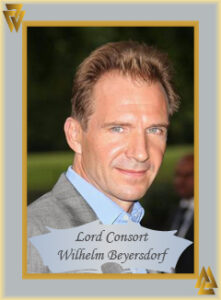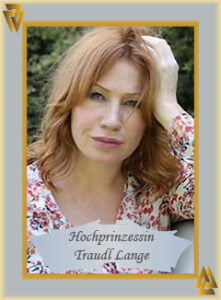Valhalla
 Der Fürstentum von Valhalla
Der Fürstentum von Valhalla
Creation
Valhalla was made real by the thoughts and memories of two people, Siegfried Hagen and Andreas Pedersen; the blood of Family; and the power of a Death Blessing.
Hagen was an ex-SS officer, and a member of the Germananorden, an extreme Aryan group who believed that the people of the Reich had come from the mythical Germania. Within their belief system, this was located around Mount Vanaheim (aka Mount Anglia), the highest point of the Sable Mountains – the ring of natural defences protecting Sable from the Reich – and Hagen set about looking for it. Not understanding the nature of the mountains, he led a group towards Mount Vanaheim and did, indeed, find what he believed to be Germania, and the Halls of Valhalla. However, the effort broke his mind, and the place was destroyed due to the intervention of Sable forces. That would probably have been the end of it, had it not been for the fact that the following day, an altercation took place at the site which led to the blood of Rupert Delatz being spilled at that location. Due to Delatz’s nature, this brought about a change in the Ruins of Valhalla, turning it into a Rock of Creation, which ended up being exploited later by Andreas Pedersen, another Germanenorden operative who had been brought up within the Lebensborn system.
Pedersen learned of what Hagen had done through a variety of sources, and set about planning how to replicate the effect and do it properly this time. He devised a ritual which he believed would rebuild Valhalla from the ruins, but realised that he would need Hagen to make it work. Unfortunately, Hagen had ended up in a mental asylum in Sable, under the care of King Robert. It took him some time, but Pedersen found a way to make Hagen available to him, and as an unexpected bonus, he also managed to capture Stephen Lacey, the King of Sable’s young ward. On the theory that two sacrifices were better than one, he arranged for both of them to be taken to the Ruins of Valhalla and set about enacting the ritual which would rebuilt the place in a more orderly fashion. As before with Hagen, Sable operatives interrupted the ritual before it was completed, but not before he had begun the sacrifices and blood had been spilled. Ultimately, they were saved and he was killed, but as he died, he pronounced a Blessing upon his creation: “May this place stand forever, and its enemies fall”. Thus the formation of Valhalla gained its own momentum.
What is Valhalla?
Valhalla was initially a pocket Shadow, woven out of the weird stuff of the Sable Mountains and anchored to them. At first, it was located about 150 miles into the mountains from the Sable side. However, King Robert was undestandably unhappy about the proximity to his own lands, and worked with RFSS Delatz to shift the original physical site closer to the Reich itself, on the edge of the mountains on the Schweiz/Franca border. The mountains moved around it, so that it cannot be reached by normal people, protecting it much as Sable itself is protected.
However, the fact that it was built on the blood of multiple Family members (Siegfried Hagen and Andreas Pedersen), and fuelled by a Death Blessing gave it the potential to become more than just another pocket Shadow. Since its relocation, it has effectively spawned into a seperate world, probably occupying a similar space in the metaphysical cosmos as Argent. It is very stable and very permanent, and has become a Shadow of Destiny for the the souls those who die, or have ever died, who believe in the Norse myths in the Sable-Aurellis universe. As the Norse beliefs are more prominent within the SS than other population group on the Inside, Valhalla is effectively an SS nation. As far as the living is concerned, it can also be reached by the close family (parents, siblings, children) of those whose blood was spilled to create it.
At this point in time, Valhalla comprises an area of about 840k square miles (about the size of Greenland), and seems to be expanding as more souls find their way there, as if it is adapting to welcome those who deserve to be there. It is split into two primary regions: a major city of somewhat Medieval appearance, which has formed around the Place of Blood – the holy of holies in Valhalla, and the very heart of the nation; and the more rural Fólkvangr. The city, also called Valhalla, is of indeterminate size and population, but forms the religious and governmental centre of the Principality. Fólkvangr is a strange mixture of volcanic and idyllic agrarian landscape, dotted with small towns and villages; and training grounds, where the forces of Valhalla can keep their skills sharp and train for the sheer pleasure of training, to prepare for the final battle. Storytelling and drinking are other popular pasttimes.
Economically, Valhalla is completely self-sufficient. The land is rich and fertile, and it can grow all its own food – assuming its residents need food, which hasn’t been proven as yet. Likewise, it can satisfy all the material needs from the abundance of natural resources which have formed within it.
The Valhallans
The Valhallans are the re-embodied souls of those who have died believing in the Norse myths. Dominant among them are those of warriors who have died with honour and a true belief in the rewards of Valhalla and its sister realm, Fólkvangr, including all members of the Honour Guard and all Knights of the SS who have died in good standing.
The ruler of the Valhallans is Hochprinzessin Traudl, the first Priestess of the Knights of the SS, mother of Andreas Pedersen (with Joachim Peiper), whose Death Blessing gave Valhalla life and form. They are closest in nature to the Argentians, and appear to have physical form, and they are able to manifest day and night. More recently, it has become apparent that some of them have the potential to return to the real world, most visibly their ruler. Mobility seems to depend on who they were in life, whether they were Family and whether they had any form of Power. None of them have tried to leave Magica Superior as yet.
They hold the Norse gods in reverence, especialy those they consider to be the key members of their pantheon: Odin, Freya, Freyr,Thor and Heimdall. Loki also has some influence with certain of the Valhallans. They also hold RFSS Delatz in high esteem: being predominantly SS, he was always the one to whom they held their first allegiance.
Key Players
Hochprinzessin Traudl Lange, Mistress of Valhalla, formerly KSS (Winter Circle)

 Hochprinzessin Traudl came to the Reich in its very first days, and co-founded the Knights of the SS with Rupert Delatz. As far as the historical record goes, throughout her career within the SS, she was the commander of the Ahnenerbe Forschungs und Lehrgemeinschaft, holding the rank of Oberstgruppenführer: one of the few women, even now, to be given that rank.
Hochprinzessin Traudl came to the Reich in its very first days, and co-founded the Knights of the SS with Rupert Delatz. As far as the historical record goes, throughout her career within the SS, she was the commander of the Ahnenerbe Forschungs und Lehrgemeinschaft, holding the rank of Oberstgruppenführer: one of the few women, even now, to be given that rank.
She had a reputation as a smart, efficient operator, who held her own within the largely male-dominated SS throughout her career. She believed deeply in the Ahnenerbe’s mission, and was also responsible for establishing the Lebensborn Eingetragener Verein, to help improve the bloodlines of the newly-established Reich.
Traudl and Rupert were married in the eyes of the SS – but not the Imperial Council – from RY101-120. In the end, however, they seperated and she married Wilhelm Beyersdorf, another Knight, in RY130. She had two children with Beyersdorf: Sophia (b.RY038) and Victor (b.RY040). She was killed by General John Graham and a Sable Hunting Party in May RY074, although she managed to take at least two of her attackers with her.
With the founding of Valhalla, as the Fallen attained their reward, Traudl quickly established herself as their ruler, and was responsible for agreeing the alliance with Rupert Delatz, on behalf of the Kaiser and the Reich, on 1 October RY154. She was joined in Valhalla by her husband, who is officially her Lord Consort as well as Chief of Security for Valhalla.
Prinz Alexander, Warleader of Valhalla
In life, Alexander Diethelm was an early luminary of the Waffen-SS, and was one of the founding members of the Knights of the SS. He came to the Reich in its very earliest days, and struck up a good working relationship with his superior officer, Joachim Peiper. He was also one of the first senior Waffen-SS commanders to die, in September RY027.